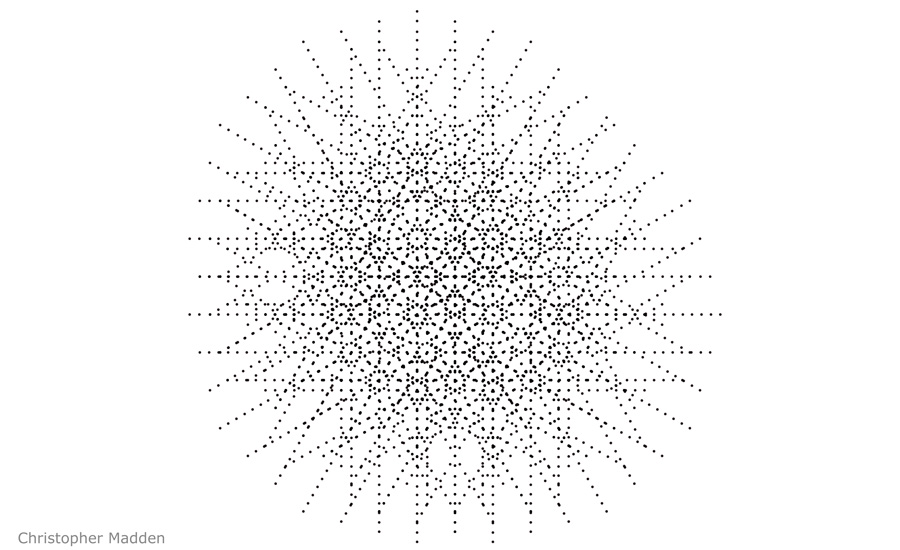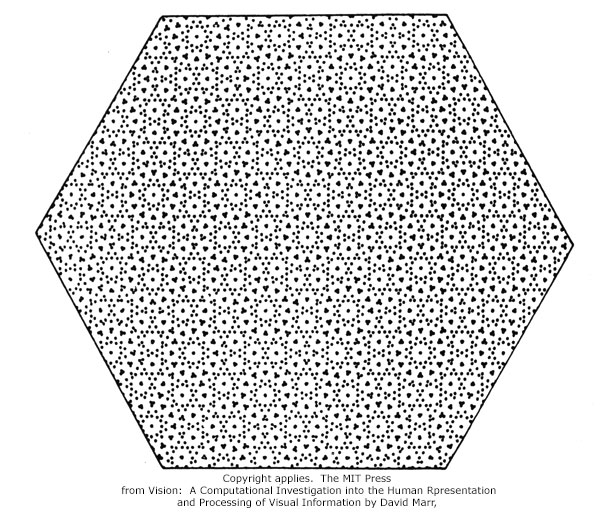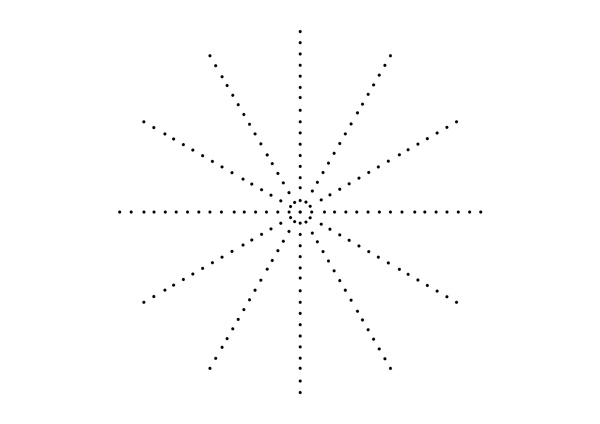
The perception of pattern. Ambiguously decipherable interlocking patterns of dots
Patterns generated by superimposed lines of dots
This image is inspired by a diagram by David Marr (1945-1980), a British neuroscientist who worked extensively in the field of visual processing.
The David Marr image, shown below, was concerned with the way in which the human eye (and brain) will scan images seeking out understandable patterns. The image reminded me very much of some of the images that I’ve produced myself that involve the perception of pattern (before I’d seen the David Marr image), both in its form (arrays of dots) and its intension (the generation of ambiguously decipherable interlocking patterns).

Naturally I was inspired to deconstruct the David Marr image so that I could then try to create my own images based on what I found. The image at the top of this post is the first result.
After studying David Marr’s image I worked out that a simplified version of it could be constructed from multiple versions of the basic star-like element shown below, with each element placed at an equal distance from the adjacent elements.

I call this star-like image a basic element, but that’s slightly inaccurate.
This ‘basic element’ isn’t really a basic element at all, because each ray of the star is a rotated repetition of an even more basis element, this being a row of thirty three dots in a straight line. See the image below. So in some ways the element in the image above isn’t really a star-like shape at all – it’s actually a set of six lines of dots rotated to different degrees.

Just one more thing.
When you look at the innermost dots centre the star-like element above you see a clearly defined inner ring of dots and probably a less obvious secondary ring of dots. These ‘innermost dots’ are only ‘innermost dots’ if you choose to define the dots that are closer to the centre of the figure as a separate entity (a ring). In truth all of the dots in the image have the same status (other than that of their position), all being simply dots in lines, it’s just that the ones closest to the centre most easily form a ring when interpreted by our brains. Our brains can interpret the second set of dots as a secondary ring because you can, when you concentrate slightly, see that they are linked into this formation by association with their neighbours, although more loosely than is the case with the emphatic inner ring. What you won’t notice though is that the next set of dots outwards also form a ring, as do the next set and the next set all the way out to the end of the rows of dots. You can’t see this because for all of the dots beyond the secondary ring the dots are too well separated for the eye to associate them with each other. Somewhere in the space between the secondary ring of dots and the next dots outwards a threshold is crossed at which the brain can’t hold the dots together as a ring – the association is broken.
It’s interesting that this explanation was intended to be about the relatively complex image at the top of the post, but I’ve spent most of my time dissecting the simpler star-like image of the underlying element. Fortunately, the points that I’ve made about the underlying element are exactly the points that can be applied to the more complex image, and thankfully without the excessively complex structures within the complex image conspiring to befuddle the brain.
The David Marr image was featured in the introduction to the book Art Forms in Nature, featuring the drawings of German biologist and artist Ernst Haeckel (1834-1918), published by Prestel, 1998.

